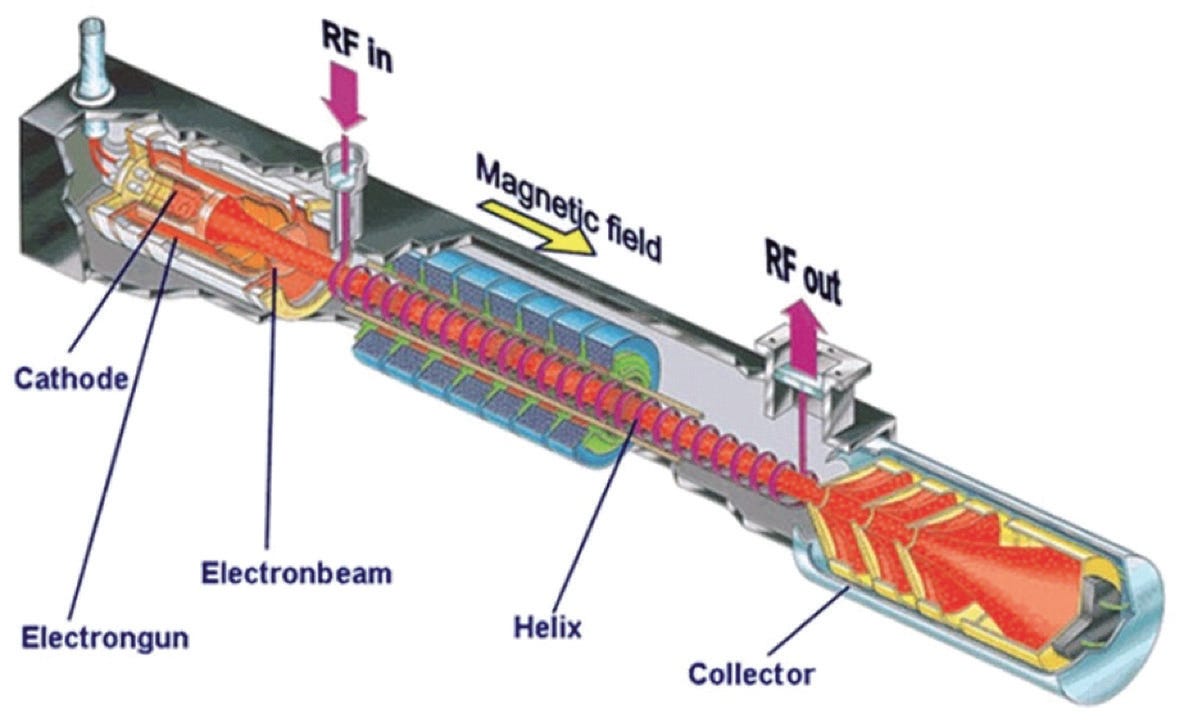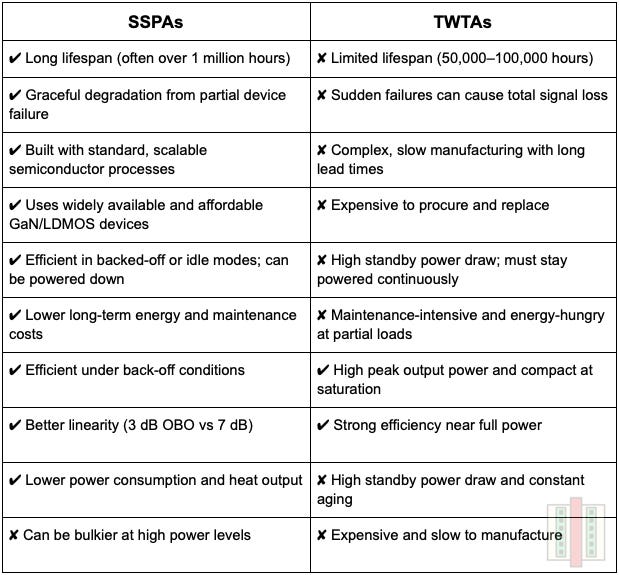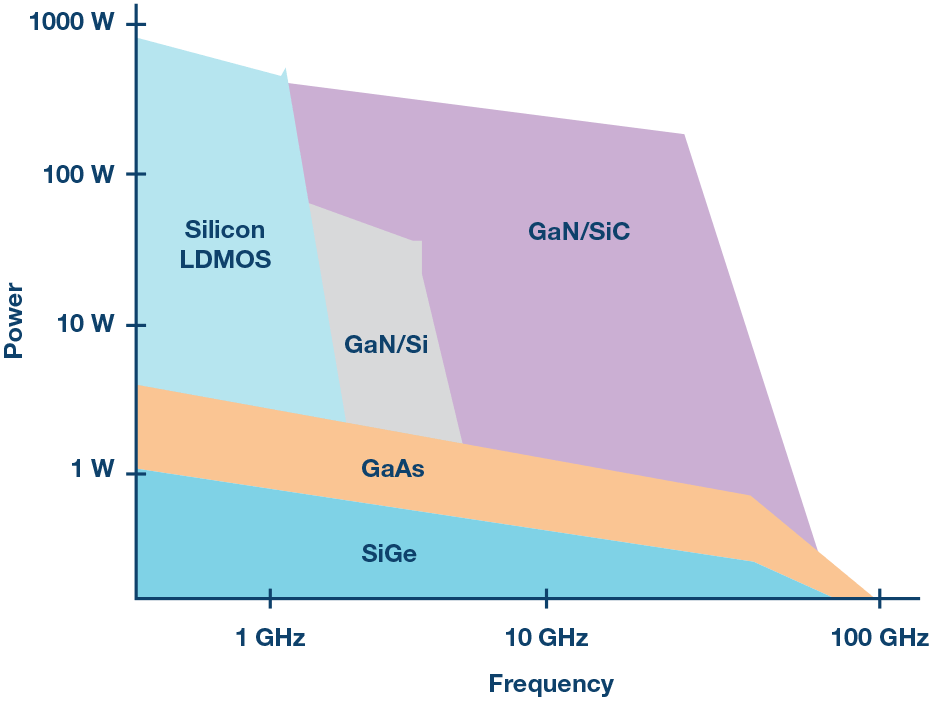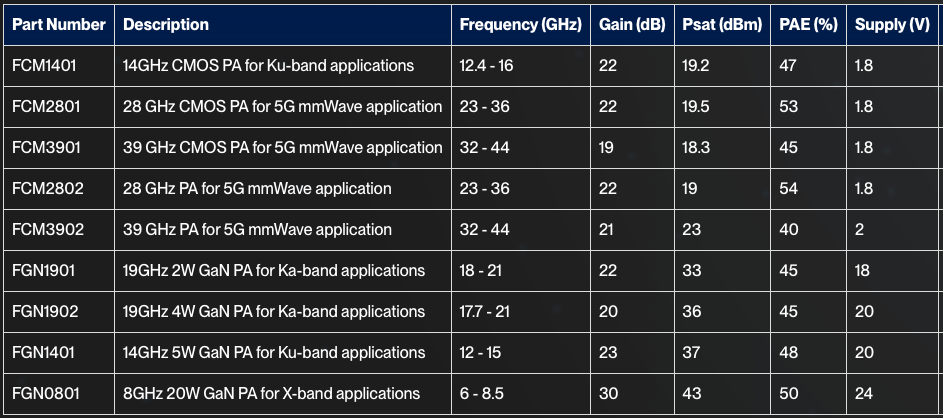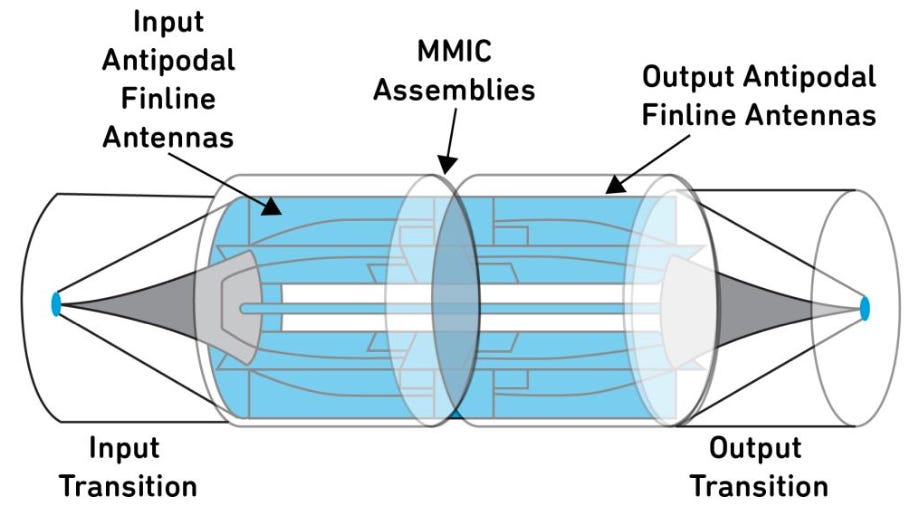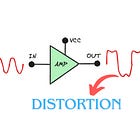Why the Future of RF Amplification in Satellites is Solid-State Devices on GaN
Exploring the technology, trade-offs, and system-level impact of GaN-based power amplifiers that are slowly replacing vacuum tube technology used in satellite communications.
Welcome to the occasional free Sunday deep-dive edition of my weekly newsletter. Each week, I help readers learn about chip design, stay up-to-date on complex topics, and navigate a career in the chip industry.
If you’re new, start here. As a paid subscriber, you will get in-depth content like this post and access to an ever growing library of resources and archives. We also have student discounts and lower pricing for purchasing power parity (see discounts). Consider expensing the cost of this subscription. Send this email to your manager.
If you’re not a paid subscriber, here is some content you’re missing out on.
Why LEO Satellite Markets Are Brutally Exclusive and What to Do About It
Understanding High-Voltage DC Power Architectures for AI Megafactories
A Detailed Playbook to Leveling Up Your Meetings, Mentorship, and Career Conversations
If you have an interesting trend you’d like to discuss on this newsletter as a guest co-author, send me an email at substack@vsekar.com. I’ll get back in touch with you.
Today’s post is co-authored with guest, Gregory Junek — Business Development Manager at Falcomm. I had the pleasure of chatting with the executive team at Falcomm at IMS 2025, where we talked about directions for the satellite communications (SATCOM) industry — all centered around amplifiers and GaN.
SATCOM requires amplifiers that produce hundreds of watts of output power, which has traditionally only been possible with vacuum tube-based technologies like traveling-wave tubes or klystrons. Solid-state amplifiers built with Gallium Arsenide or Silicon Germanium are no match for vacuum tubes operating at such high power levels. And, silicon technologies do not deliver the performance needed for high power RF.
With the advent of Gallium Nitride (GaN) technology, there is now a real competitor on the scene. Today, we’ll explore a key trend in SATCOM — the shift from traveling-wave tubes to solid-state power amplifiers (SSPAs) using GaN.
With the global SSPA market for SATCOM amplifiers projected to surpass $1.2 billion by 2033, the momentum behind this technology reflects more than just technical progress. As demand grows for higher data rates and more flexible payloads across satellite networks, SSPAs offer a scalable and cost-effective alternative to traditional vacuum tube technologies.
By reducing system complexity and operational risks, SSPAs are unlocking new opportunities for satellite operators and manufacturers, driving innovation in broadband, defense, and 5G backhaul applications. This expanding market highlights how SSPAs are transforming satellite system design while redefining the business landscape for growth and innovation in RF amplification.
In this article, we will discuss:
Power amplifier concepts for SATCOM: A brief introduction of concepts that are required to understand the evolution of power amplifier technologies in satellites.
Technologies for SATCOM PAs: An explanation of traveling wave tube amplifiers and solid state amplifiers based on GaN technology, along with their merits and demerits.
GaN-on-Si as a key technology enabler: The role of GaN-on-Si/SiC in RF amplifier technology.
Deep-dive into solid-state PA performance: Output power, efficiency, linearity, redundancy and reliability.
Astranis Omega: How SSPAs are enabling software-defined payloads.
Read time: 14 mins
About Falcomm
Falcomm is a fabless semiconductor company born out of Georgia Tech, based in Atlanta, focused on SSPAs for SWaP-constrained SATCOM systems. Their patented Dual-Drive PA architecture delivers high power-added efficiency, strong linearity, and wide bandwidth—even in high back-off conditions. They’re also developing GaN-on-Si amplifiers that balance efficiency and linearity with silicon’s scalability and cost advantages, aimed at tightly integrated systems where GaN-on-SiC is oversized in cost or thermal load. Falcomm isn’t replacing legacy hardware—they’re rethinking RF power for digitally driven platforms. Their amplifiers are being tested in satellite payloads, sUAS, tactical radios, and RF front ends where traveling wave tube amplifiers fall short. See their website for more details.
Disclaimer: This is not a sponsored post, nor do I hold any investment or advisory roles in Falcomm. This post is an industry collaboration to explore emerging tech trends and does not reflect the views of my past, present, or future employers. Views are solely mine and does not constitute investment advice.
Power Amplifier Concepts for SATCOM: A Primer
One of the most critical components in a satellite communication system is the power amplifier (PA). Its function is to convert supplied DC power and amplify an input RF signal to levels high enough for transmission between orbit and ground-stations through antennas. A few desirable characteristics of such amplifiers are listed below:
Small size and weight: Satellite payload is expensive. Launch costs are reduced when components are smaller and lighter.
Reliability: Electronic systems are hard to replace once they are in orbit. They should survive both launch and orbital conditions over the lifetime of the satellite.
Linearity: The amplifier should not distort the signal being amplified. The signal path from orbit to ground-station has plenty of imperfections already; the power amplifier should not add to it.
Backoff efficiency: The amplifier should generate a lot of RF power for every watt of DC power consumed — a metric called power-added efficiency (PAE). Satellite PAs consume 80-90% of spacecraft bus power, and hence PAE is of utmost importance. Normally, efficiency is best when the input signal has a large voltage swing, preferably to the DC supply rails. This way, a large part of the DC power provided is used for amplification (my very first post on this newsletter discusses this.)
Sadly, what is best for efficiency is not so for linearity. Running an amplifier at high voltage swings distorts the output signal. To minimize distortion, the signal level sent to the amplifier needs to be ‘backed-off’ from peak efficiency condition. When doing so, the linearity improves but efficiency degrades. It is preferable if the efficiency degradation is somehow arrested by choice of proper technology or circuit architecture.
We will use all these concepts in the sections below.
Technologies for SATCOM PAs
There are two fundamental candidate technologies for SATCOM PAs:
Traveling wave tube amplifiers (TWTAs) have been the primary choice in satellites for many decades, and still occupy a large portion of the market share in SATCOM PAs.
Solid state power amplifiers (SSPAs) which are emerging as an alternative to TWTAs whose competitiveness comes from the use of GaN-based technologies.
We’ll discuss each one briefly below.
TWTAs
TWTAs have been used in satellites ever since the birth of space communications. A TWT is a vacuum electron device that amplifies an RF signal through interactions with an electron beam. The electron gun emits an electron beam from a cathode heated to ~1000°C and is received at the collector. The RF input is coupled into the electron beam and the amplified RF signal is received at the output. The helix and magnetic field control the energy exchange process that results in signal amplification.
TWTAs using helix structures are capable of providing high power at high frequencies with broad bandwidth and good efficiency, while withstanding high temperatures. This explains why they have been so widely used in satellites. For example, Thales’ S-band (2.15—2.76 GHz) TWTA produces 275 W of RF output power, for satellite downlinks. The exceptional performance of TWTAs at Ka-band (27—40 GHz) is largely uncontested in terms of output power. However, their limitations primarily come from two sources:
Cathode lifetime: There is a limited supply of electrons in the cathode, and they get used up. Although TWTAs have been shown to operate fully over the lifetime of a satellite (~20 years), the cathode ultimately limits TWTA life.
High operating voltages: The electron gun needs several kilo-volts (kVs) from the power supply to generate the electron beam. These kV-level power supplies are heavy and expensive, and increases weight of the satellite payload.
TWTAs have been steadily improving over the years, but the advent of GaN for amplifiers has been a game changing advancement for SSPAs.
SSPAs
SSPAs have been around since the 1970s and were typically built with Gallium Arsenide MESFETs which were limited by low voltage handling and insufficient output power. Recent advances in Gallium Nitride (GaN) technology have made SSPAs a suitable replacement for TWTAs because output power is on-par with what TWTAs provide.
Advantages of SSPAs
High volume, low cost semiconductor manufacturing enables large constellations with >10,000 satellites to have low-cost, mass produced amplifier modules.
Lack of mechanical assemblies/moving parts means that there is lower risk of mechanical damage to SSPAs in the launch process.
Low operating voltages are required for controlling GaN devices in SSPAs, typically in the range of <50 V in contrast to the kVs needed for TWTAs.
Instant on/off capability of SSPAs means that amplifiers can be powered off to save energy and power up quickly on demand. This has implications in satellite redundancy systems that we will discuss later.
Noise and linearity in SSPAs are much better than TWTAs. For example, the noise figure of a medium power GaN amplifier is ~10 dB, while an equivalent TWTA can be ~30 dB. GaN SSPAs also have much lower output distortion.
Thermal: SSPAs generate a lot of heat in a small transistor area — usually in a few squared millimeters — and needs to be dissipated with heat sinks. Because they draw less current when operated below saturation, the heat they generate is lower for a given output level. That can simplify thermal design and reduce operational costs over time especially in SWaP constrained systems.
Disadvantages of SSPAs
Peak Efficiency: Compared to TWTAs, solid-state implementations provide lower peak efficiency. As we will discuss later, peak efficiency does not matter in the context of power back-off and GaN SSPAs emerge with unique advantages.
Frequency and bandwidth limitations: For lower frequencies, SSPAs can compete with TWTAs, but for high power and high bandwidth applications in the mmWave frequency range (> 30 GHz) often required in military applications, the performance offered by TWTAs is hard to beat.
The result is an ongoing shift in how RF systems are designed and deployed in space. SSPAs are no longer a compromise, they’re becoming the preferred option for satellite platforms that demand performance, reliability, and scalability without the legacy baggage of vacuum tubes.
GaN on Silicon as the Key Technology Enabler
While GaN on SiC remains the benchmark for high-power, high-efficiency amplifiers in demanding RF environments, GaN on Silicon (GaN-on-Si) is quickly emerging as a viable alternative for many SATCOM applications. Its appeal lies in scalability, low cost, and great performance.
By leveraging the mature silicon manufacturing ecosystem, GaN-on-Si enables lower-cost, high-volume production of RF GaN power amplifiers. It also offers better compatibility with CMOS-based digital control and signal processing, which simplifies integration into compact, software-defined payloads. For highly integrated systems such as phased arrays, small GEO satellites, and small Unmanned Aircraft System (sUAS) platforms, this combination of performance and scalability presents another critical advantage.
Although GaN-on-Si does not yet match the thermal performance or raw power density of GaN on SiC, ongoing improvements in packaging, substrate engineering, thermal mitigation, and high-efficiency PA design are closing that gap. For moderate power levels where size, weight, and cost must be tightly managed, GaN-on-Si-based SSPAs offer a compelling balance between efficiency and manufacturability.
As SATCOM platforms become more distributed and modular, the shift toward scalable amplifier technologies like GaN-on-Si will continue to gain momentum enabling broader adoption of solid-state solutions across space, air, and ground networks.
To understand why SSPAs are a suitable replacement for TWTAs, we will look at the following in greater detail: output power, efficiency, linearity, redundancy, and reliability.
Output Power and Efficiency
While a single TWTA can produce hundreds of watts of output power, SSPAs can produce up to 20W from a single chip with up to 50% efficiency using unique circuit architectures, as shown in Falcomm’s product portfolio below (some are still in development.) The same table shows the benefits of using GaN over CMOS to achieve high levels of output power (Psat).
Tens of watts is by no means the limit of what GaN is capable of. For example, Qorvo uses their proprietary QGaN25HV GaN-on-SiC process to make amplifiers that produce 100 W from a single packaged chip whose size is 7 mm x 7mm.
For higher power levels, Qorvo’s Spatium technology spatially combines the output of multiple GaN SSPAs using a series of carefully designed transitions and power combining networks. Their Spatium amplifier operating at X-band (8-11 GHz) produces an output power of >500 W, PAE in the mid-30%s, with a supply voltage of 28V, clearly showing that GaN SSPAs can deliver output power levels only previously achievable by TWTAs but in a much better form factor.
Linearity Performance at Power Back-off
Just as important as output power is how amplifiers perform under complex signal conditions. In satellite communications, amplifiers often need to handle multiple carriers or wideband digital signals. This makes intermodulation distortion (IMD) a key performance factor, as excessive distortion can degrade signal quality and cause interference with adjacent channels.
A standard way to characterize this is the two-tone test, where two closely spaced signals are passed through the amplifier, and the resulting third-order intermodulation distortion products (IMD3) are measured. Read more below if you want to learn about nonlinear metrology in amplifiers.
These unwanted signals appear close to the main carrier frequencies and can’t be filtered out easily. Most SATCOM systems require IMD3 products to be at least 25 dB below the desired signals (–25 dBc), which means amplifiers must operate in their linear region, well below their maximum output rating. This leads to the concept of power back-off which we briefly mentioned earlier.
Output back-off is a measure of how far away from its maximum rated output power the PA is operated at.
Here are some numbers to give you an idea:
3 dB back-off = 50% of max power
4 dB back-off = 40% of max power
5 dB back-off = 31.6% of max power
Let’s take the example of a PA that has an output power of 100 W for maximum efficiency.
To meet linearity requirements, a 100 W TWTA typically needs to operate with 7 dB of power back-off. This corresponds to 20% of the output power, or 20 W. Since a GaN-based SSPA is inherently more linear, it only needs around 3 dB of power back-off to achieve similar distortion levels. This corresponds to 50% of the output power or 50W. That 4 dB difference (or 30W) translates directly to efficiency and operating margin.
Even though a TWTA might have higher absolute output power and efficiency, the amount of usable “linear power” is often much lower compared to SSPAs. In such situations, GaN SSPAs can exceed the performance offered by conventional TWTAs.
This distinction has major implications for system size, weight, and power consumption. Since TWTAs still draw near-peak power even when backed off, their actual efficiency in communications systems is often much lower than spec sheets suggest. SSPAs not only deliver higher linear efficiency, but they also allow for more compact, lower-power system designs.
Redundancy
Satellite systems are always operated in redundant configurations, with a redundancy controller system in place to monitor and implement failovers. Two commonly used approaches are shown below:
In a 1:1 redundancy system, there is an active amplifier and the other one acts as a spare, and can be switched in during failure of the active amplifier. The power switching circuits result in a loss of 2-3% of output power due to dissipative losses.
A 1:2 redundancy system typically involves three amplifiers: two are combined in operation, and a third acts as a standby amplifier that can replace either of the two active ones if they fail. The losses in combining and switching circuits causes a reduction of 8-10% of output power.
The ability to turn on and off SSPAs with short startup times makes them very attractive from a power consumption perspective. The backup amplifier can be kept off, and turned on only when required. SSPAs operate efficiently in backed-off conditions and can be shut off when idle, which helps conserve energy and extend component life.
TWTAs have long startup times because the cathode needs to heat up to have a stable electron beam. TWTA backup amplifiers need to be kept running all the time and consumes a lot of power from the satellite bus.
Reliability
SSPAs offer major advantages in reliability, manufacturability, and lifecycle cost. Unlike TWTAs, which rely on delicate vacuum tubes, SSPAs have no high-voltage components or moving parts. They are more tolerant of shock, thermal cycling, and radiation, which makes them well suited for modern SATCOM systems in space and on the ground.
TWTAs still deliver high efficiency at peak power and have a compact form factor. But they are expensive and slow to manufacture, requiring precision alignment and vacuum sealing. Lead times can stretch to a year or more. Lifespan is limited, typically between 50—100 thousand hours, and failures can happen without warning, immediately disrupting service.
SSPAs, in contrast, often operate beyond 1 million hours. In designs that combine multiple MMICs or transistors, a single device failure causes only a slight drop in performance rather than a total outage. This graceful degradation improves system uptime and reduces maintenance risk.
They are also easier to produce. SSPAs are built using standard semiconductor processes and commercial high power transistors, which are widely available and much less costly to replace. While TWTAs may be more efficient at full saturation, they lose efficiency at lower power levels and must stay powered continuously.
Astranis Omega: A Case Study in the Switch from TWTAs to SSPAs
One of the less obvious but equally important benefits of SSPAs is their ability to integrate with modern, software-defined payloads. Many SSPAs today include built-in telemetry, automatic level control, and pre-distortion algorithms. That makes them a good fit for agile, virtualized systems that require real-time control and monitoring.
Astranis is a great example. In their upcoming Omega GEO satellite, the company made a deliberate decision to replace vacuum tube amplifiers with custom-designed solid-state solutions. As reported by Satellite Today:
Astranis made the shift from traditional traveling wave tube power amplifiers (TWTA) to a solid-state power amplifier (SSPAs), custom designed by the company. [CEO John] Gedmark said the change gives Astranis more capability, flexibility, shorter lead times and lower cost for the payload.
SSPAs, especially those using modern GaN technology, are meeting the demands of modern satellite communications systems, and in many cases surpassing them. For most satellite communication systems today, the long-term benefits of SSPAs: lower cost, faster production, better reliability, and simpler maintenance, make them the more practical choice.
However, adoption of new technologies by the space industry is a slow process. Flight heritage often plays an important role in the choice of electronic systems. We will see the transition from TWTAs to SSPAs more slowly, rather than all at once.





